Friendly Workplace

Protection of Rights and Considerate Care
THSRC highly values the opinions and rights of all employees and recognizes that effective two-way communication is a crucial component of sustainable business operations. On March 31, 2022, THSRC achieved a significant milestone by signing a collective agreement with the corporate trade union for the first time. This achievement demonstrates the commitment of THSRC and the corporate trade union to collaborate and enhance the rights and interests of employees. The collective agreement includes fundamental regulations on the agreement's status, validity, and scope of application, as well as 13 articles on business leave for trade union councils and supervisors, official leave for the four statutory meetings, provision of clubhouse facilities, assistance in commuting to meetings, and assistance in labor education and training. This agreement applies to approximately 2,200 employees, which is 51% coverages. As the current collective agreement's content is based on the Company's existing labor conditions, the labor conditions and benefits of other employees not covered by this agreement, except for labor education activities, remain unaffected.
THSRC acknowledges and upholds the right of its employees to freely associate and conducts regular meetings to engage with both unions(monthly meeting with corporate unio and a bi-monthly meeting with industrial trade union), as well as quarterly employee- management meeting with each business unit and 18 areas , ensuring that their voices are heard. In 2024, the main discussion topic covered the breakfast provision for station maintenance staff, suggestions on talent retention strategies, adjustment of shift duty allowance subsidies. As a result, several initiatives were implemented, including providing breakfast for maintenance personnel, introducing a new night shift allowance, improvement of work processes, etc.
The chart below illustrates the procedure for addressing employee grievances at THSRC. In 2024, a total of 7 complaints were filed, primarily concerning interpersonal and management matters. All cases were resolved in accordance with the established employee complaint process, and all responses and cases were concluded. THSRC endeavors to enhance awareness of the process through trade union and labor-management conferences. Going forward, THSRC will remain committed to proactively addressing employee complaints to foster harmonious labor-management relations and cultivate a transparent workplace environment.
Employee Grievances Process
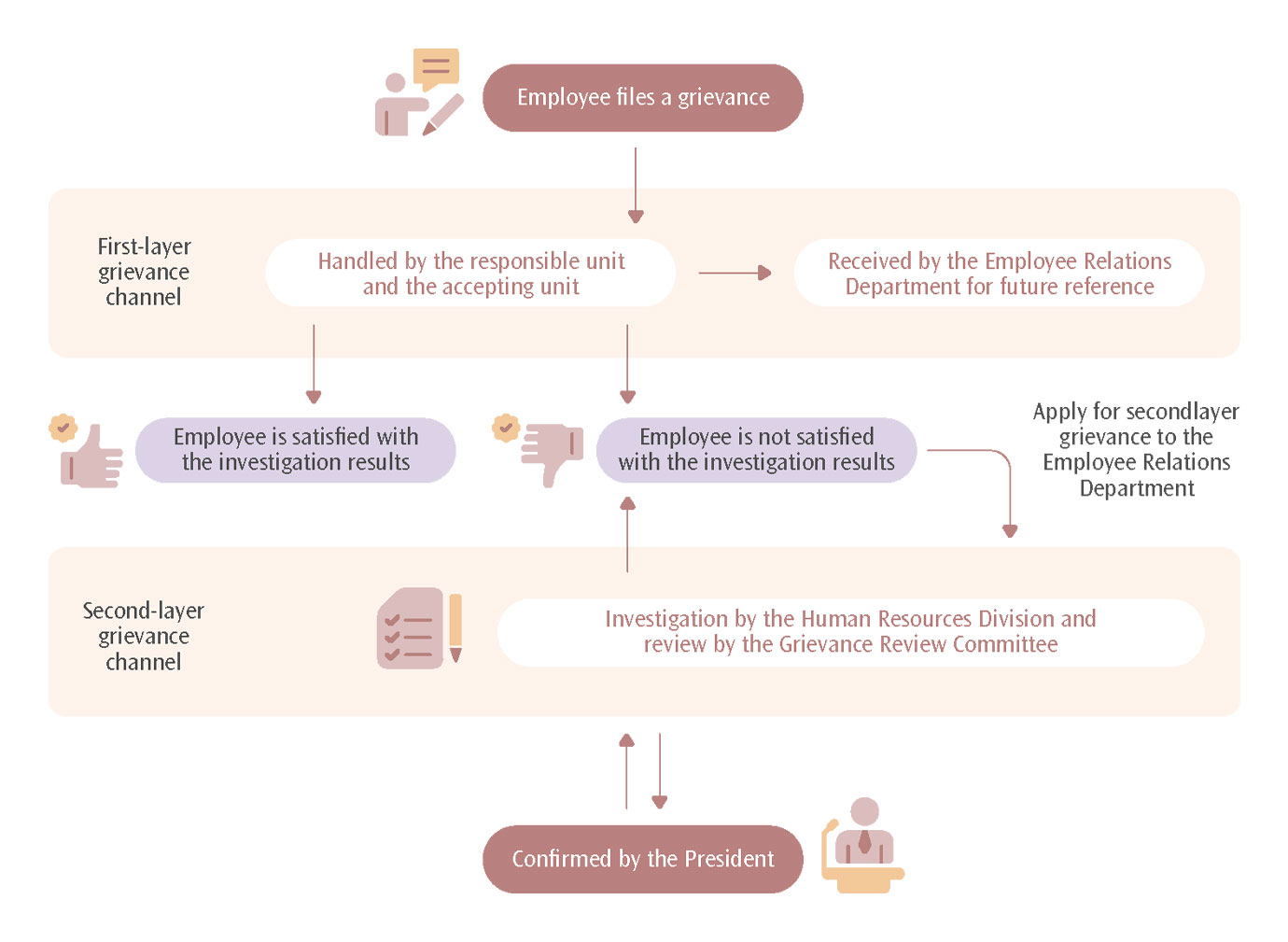
THSRC is committed to eliminating sexual harassment and has established the “Sexual Harassment Prevention and Handling Regulation.” Through physical and online education and training for supervisors and all employees, as well as specialized training for departments where sexual harassment incidents occur, we continuously conduct awareness and legal education on sexual harassment prevention for all personnel, drawing upon the circumstances of various past cases. Additionally, a Sexual Harassment Complaints Committee has been established, consisting of 13 members on a rotating basis, including internal members, external experts, and academics with legal backgrounds who serve as investigation and deliberation members. THSRC has developed a reference list of proposed sanctions and a scale of sanctions for sexual harassment cases to ensure open and fair criteria for scrutiny and to protect the physical and psychological safety of workers in the THSRC workplace. Should any such incidents occur, the company will also provide immediate psychological counseling assistance to the individuals involved, offering them channels for psychological recovery and support to ensure their mental and physical safety is restored. In 2024, 4,842 peers attended online e-learning courses, related to sexual harassment prevention, achieving a 99.3% participation rate.
THSRC has implemented internal care measures in compliance with the “Act of Gender Equality in Employment” and “Labor Health Protection Regulations” to ensure employee well-being. Additionally, the Company has established the “Mental Health Protection Regulation” to cater to the diverse needs of its employees. THSRC continuously introduced an external “employee assistance program, EAP” to create a more employee-friendly work environment. This program aims to assist employees in addressing various issues, provide timely support and assistance, and maintain their physical and mental health. Further details are as follows:
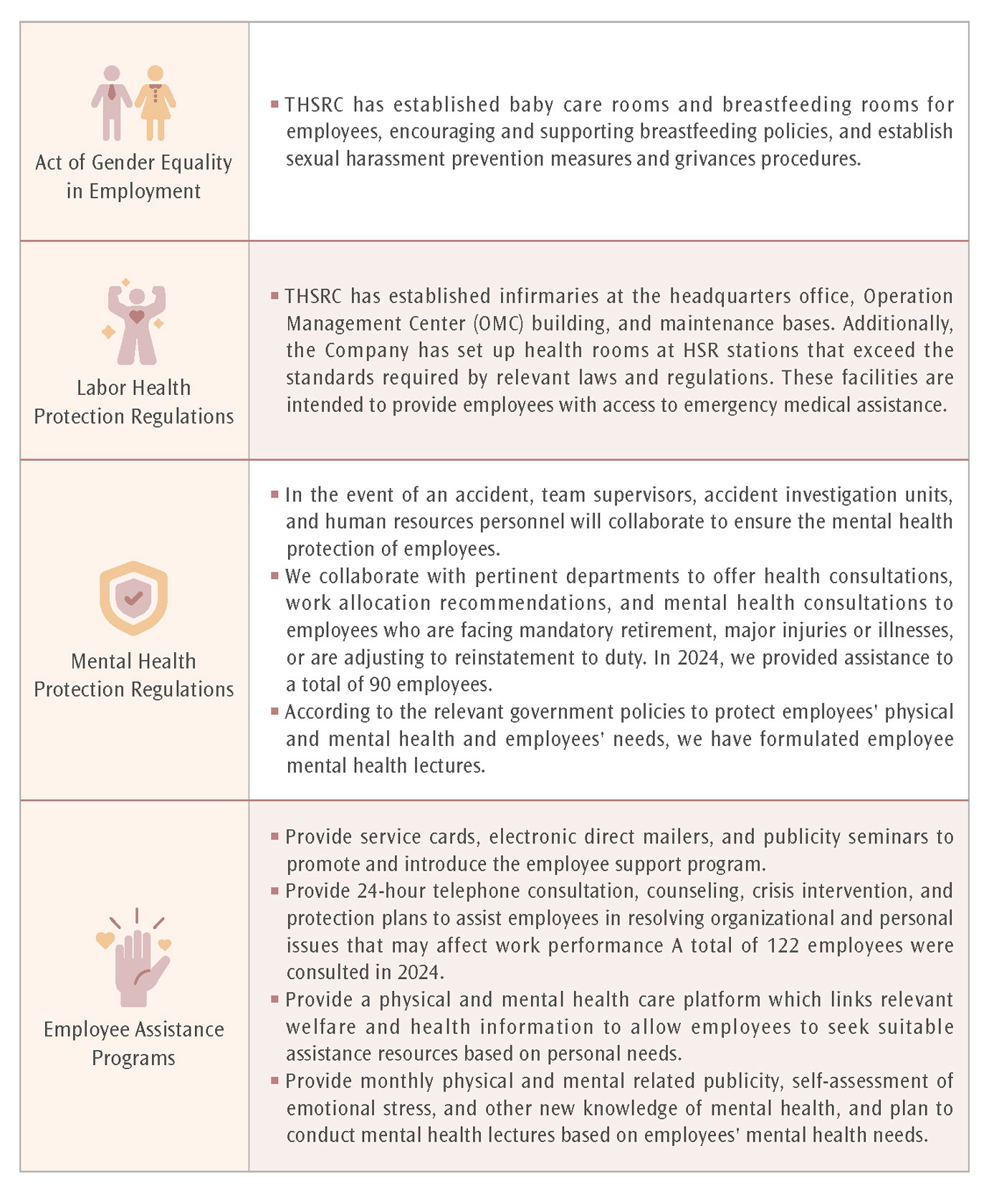
Occupational Safety Management Mechanism and Effectiveness
THSRC has implemented an occupational safety and health management system since its inception and continues to enhance its performance. In 2017, the Company achieved dual certification for the Taiwan Occupational Safety and Health Management System (TOSHMS) CNS 15506 and the International Certification of Occupational Safety and Health Management System OHSAS 18001, following a successful third-party accreditation. In 2020, THSRC passed an external review and obtained certification for (TOSHMS) CNS 45001 and ISO 45001, which have been routinely validated annually since. The Company's occupational safety and health management system encompasses stations, maintenance depots, facilities, and office spaces. At the end of 2024 the system covered 4,874 workers and 343,359 contractors.
In accordance with the provisions of the Occupational Safety and Health Act, THSRC has formulated the “Safety and Health Policy” and regularly convenes the “Occupational Safety and Health Committee.” The committee comprises one chairman, one executive secretary, and 18 members, including seven labor representatives, accounting for one-third of all committee members. The Company also holds occupational safety and health management meetings to encourage all units and labor representatives to jointly review various occupational safety and health issues. The resolutions are announced through internal and external websites.
In order to cultivate and internalize the occupational safety and health culture,THSRC continuously implements various occupational safety and health training for new comer and in-service personnel by categorized employees into for supervisors, general employee and maintenance personnel. In addition, for colleagues engaged in high-risk operations, training including production machinery, mobile elevating work platforms, hoists, construction, hypoxia operations, electric welding, and chemical use and disposal were provided as to strengthen our employees' emergency response capabilities. In 2024, a total of 4,712 employees completed these training sessions, totaling 21,270 hours. Please refer to the following table for detailed training information:

THSRC has established measurable and trackable indicators for evaluation,supported with periodic and non-periodic inspections and audits. The table below outlines the achievement of our occupational safety and health management goals for THSRC employees, contractors, and suppliers, as well as our occupational safety indicators for 2024.
Occupational Safety and Health Objectives and Effectiveness
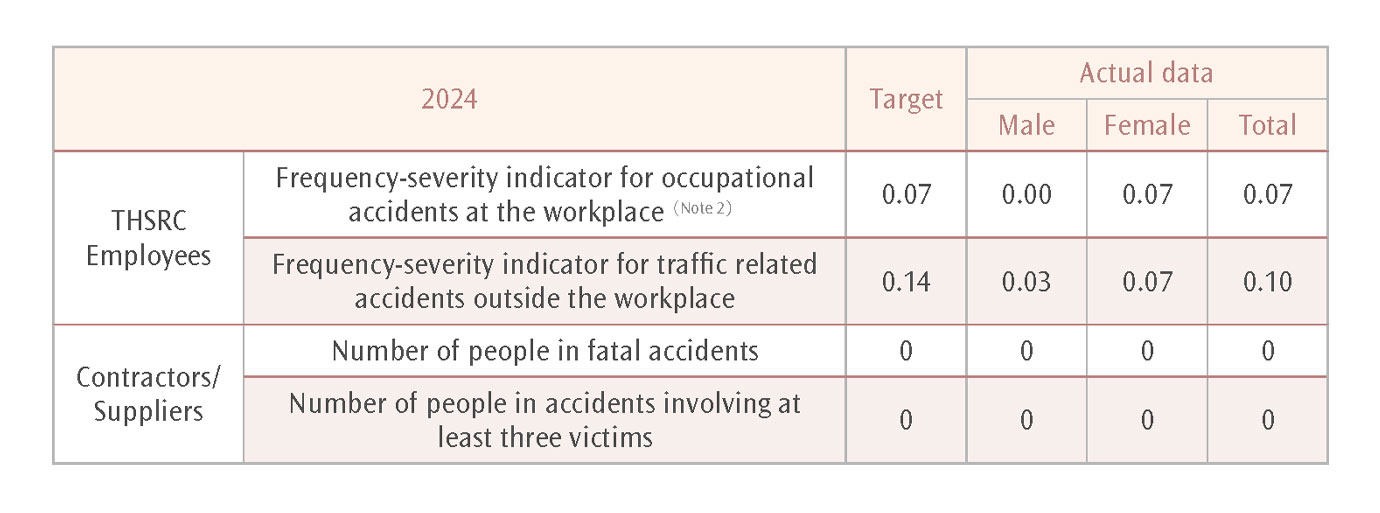
Notes:
1. The settlement date for occupational safety and health management targets was December 31, 2024.
2. Frequency-severity indicator =√(Disabling Injury Frequency Rate × Disabling Injury Severity Rate1,000).
3. In 2024, THSRC employees experienced a total of 11 traffic accidents outside the workplace.
THSRC has implemented the “Hazard Identification, Risk Assessment, and Risk Control Procedure” to address occupational hazards and reduce the likelihood and severity of occupational accident. This procedure involves identifying hazards, inspecting existing protective facilities, conducting risk assessments, and implementing control measures. THSRC has also adopted a hierarchical control system to eliminate hazards and minimize risks. Each unit has trained hazard assessment personnel who disclose hazard assessment information on the internal platform and re-check the effectiveness of hazard control measures annually to continuously mitigate and control the risk of each operation. In 2024, THSRC completed over 14,705 hazard identifications and risk assessments.
Hazard Identification, Risk Assessment and Risk Control Procedures

THSRC reminds all workers to actively report any situations that may cause occupational safety and health accidents by memorandum quateryly to reduce and avoid the risk. THSRC encouraged the reporting of Near Miss Report and integrates them into the “Voluntary Safety Reporting Platform .” In 2024, there were 206 Near Miss Report in THSRC, and 125 Near Miss Report were being confirmed. In addition, we continuously remind our employees of safety-related precautions through the “Occupational Safety and Health Bulletin Board,” “Safety Slogan,” “Consultative organization meeting,” and also reminder email from the Occupational Safety and Health Office.
If a worker discovers that there is a risk of immediate harm when performing his/her duties, the “Occupational Safety and Health Act” shall prevail in priority, and the worker can stop the operation and retreat to a safe place.The immediate supervisor who is informed will initiate subsequent measures to eliminate hazardous situations to ensure the safety of workers. In case of a disaster, after the internal and local competent authorities are informed, THSRC will immediately initiate an investigation process as per the “Occupational Accident Notification and Investigation Process,” with the aim of handling the incident effectively and alleviating the negative impact as quickly as possible. During the investigation, the immediate unit supervisor of said worker will lead the occupational accident investigation team to carry out the investigation jointly with labor representatives to ensure labor rights.
Occupational Accident Notification and Investigation Process
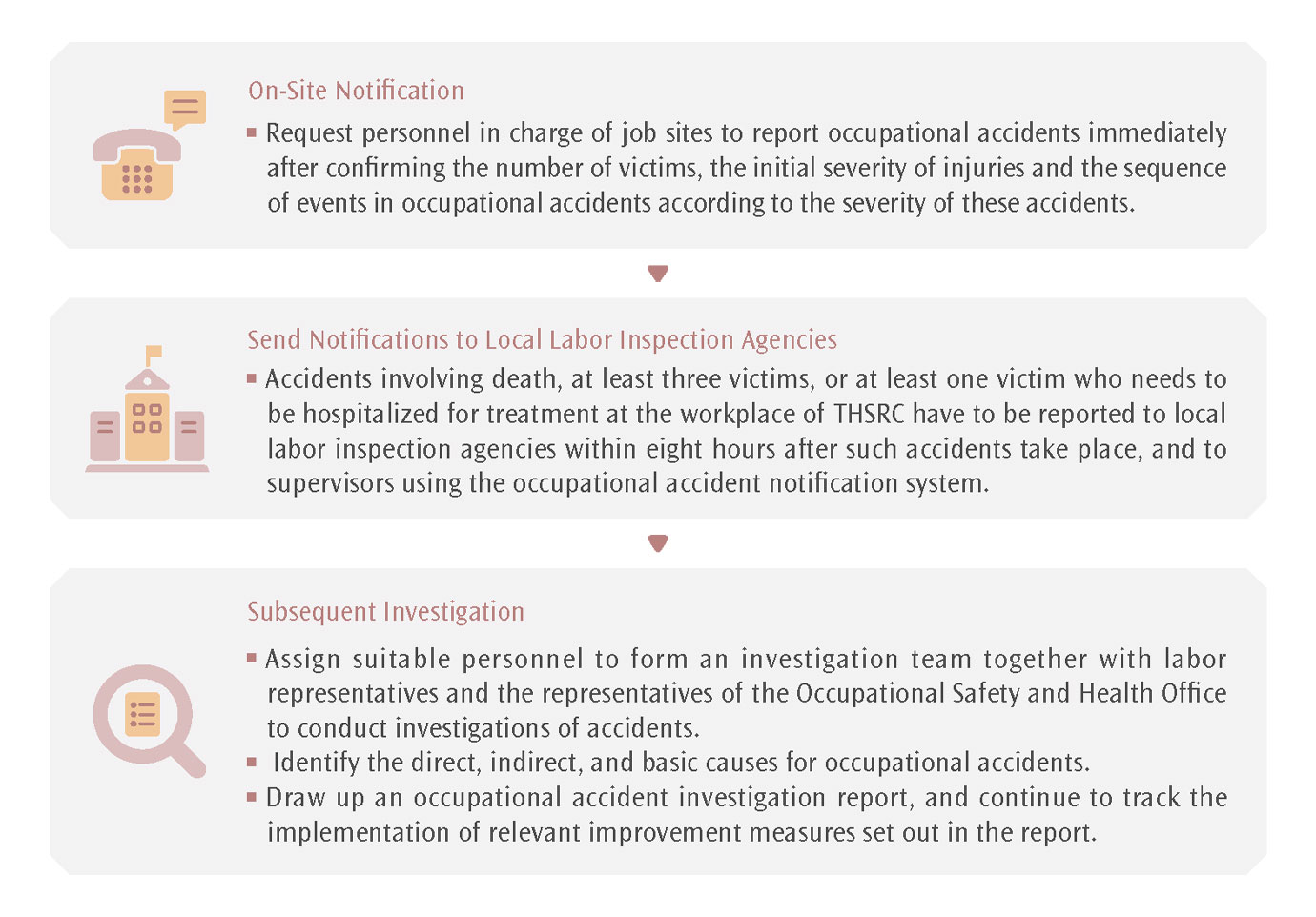
In 2024, THSRC reported no fatalities or serious injuries resulting from occupational accidents among its employees. The number of occupational accidents causing temporarily incapacity in the workplace was 6. Falls were the primary cause of occupational injuries, followed by collision by personnel. Workers who are not employees but whose work and/or workplace is controlled by the organization did not experience any occupational injuries resulting in “death” or “affecting more than three people.” THSRC regularly publicizes the occupational accident cases and false alarms that happened to colleagues through multiple communication methods such as email, occupational safety and health bulletin board, agreement organization meeting, and toolbox meeting. As well as inviting occupational safety and health experts to give safety culture lectures to establish a safety culture. The management level strengthens on-site management and inspections, strives to instantly eliminate and improve unsafe conditions, and reminds colleagues to pay attention to work safety in real time. Under the principle of “non-hidden reporting,” all occupational accidents on THSRC have been reported accurately in 2024, as well as no occupational disease-related incidents. In the future, we will continue to optimize occupational safety and health management measures to raise employees' awareness of safety protection.
Occupational Safety Index in 2024
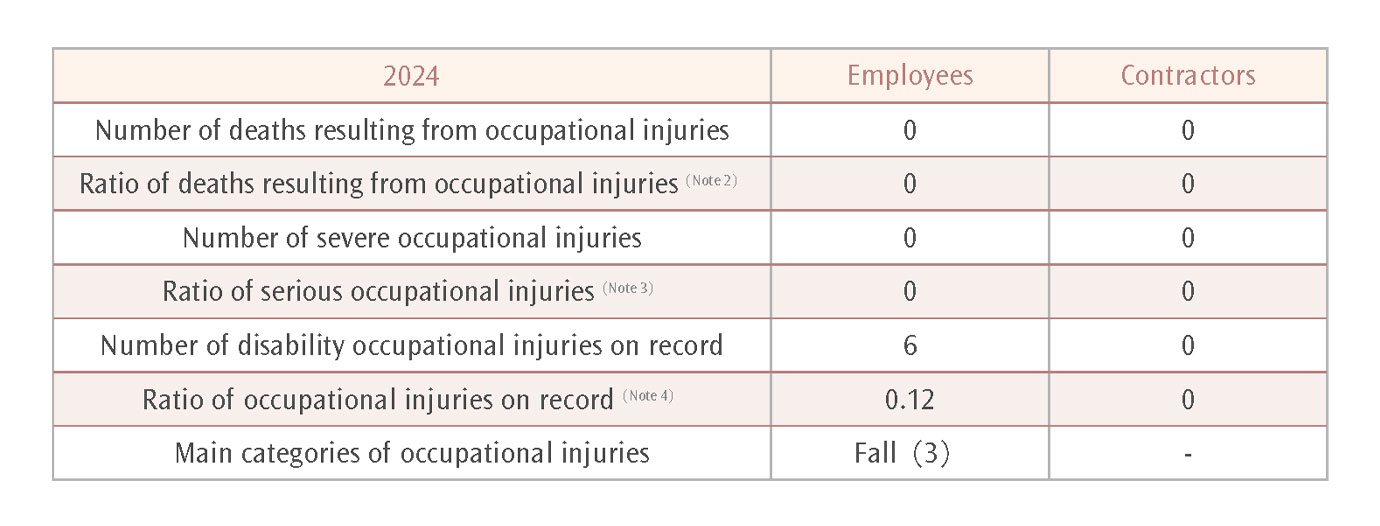
Notes:
1. This table has been computed in compliance with the Occupational Safety and Health Act, the definition of occupational disasters, and the indicators released by the Global Reporting Initiative (GRI).
2. Ratio of deaths resulting from occupational injuries = (Number of fatal occupational injuries/Total working hours) x 200,000.
3. Ratio of severe occupational injuries = (Number of severe occupational injuries/Total working hours) x 200,000. Note: 0 employees for 0 day; 0 contractors for 0 days.
4. Ratio of disability occupational injuries on record = (Number of reported disability occupational accidents/Total working hours) x 200,000. 6 employees for 7 days; 0 contractors for 0 days. This calculation has excluded Notes 2 and 3.
5. Total working hours for employees were 9,668,912 hours. For contractors, the total working hours were calculated as: annual cumulative number of people entering and leaving the venue (343,359 people) * 8 hours per day = 2, 746,872 hours.
THSRC has consecutively passed the “Healthy Workplace Certification - Health Promotion Label” certification of the National Health Administration for second times (certification every 3 years), and actively implements a smoke-free environment in the workplace. It has been awarded the sports enterprise certification mark of the Ministry of Education for three times, which shows that the company's investment in promoting employee health and sports has been affirmed. The health promotion activities carried out in 2024 are as follows:
Note:
1. THSRC's medical check-up measures exceed legal requirements: Employees aged 45 and above will receive a check-up annually, while those under 45 receive one every two years. Driving personnel receive a check-up annually.
2. Contractors can also access health promotion services (excluding annual medical check-ups).
“T-SPORT” Series of Activities for THSRC Personnel

THSRC adheres to the concept of “happy employees create a joyful and touching riding experience for passengers,” provides a transparent and fair compensation system, as well as multiple benefits such as childcare support, work-life balance, work assistance, and subsidies. We have established an employee welfare committee in accordance with the law and regularly review our internal welfare policy through market surveys conducted by external consulting companies to ensure competitiveness. THSRC also explores ways to protect employees' wages and career development without restrictions, encourage employees “Worry-Free about Pregnancy, Childbirth, and Childcare.” For employees who apply for statutory unpaid leave, including parental, injury, illness, and military service, regardless of gender, if the Company implements a salary adjustment during the unpaid leave, the annual salary adjustment system can still be applied after reinstatement to protect their working conditions. In 2025, THSRC will launch the “THSRC Project of Childcare” to introduce incentive and subsidy policies for childbirth, parenting, and education, including cash allowances and two days of paid family care leave—benefits superior to statutory requirements—to attract and retain talent, and to continue building a sustainable and happy enterprise.
THSRC Employee Benefits and Work Support Items
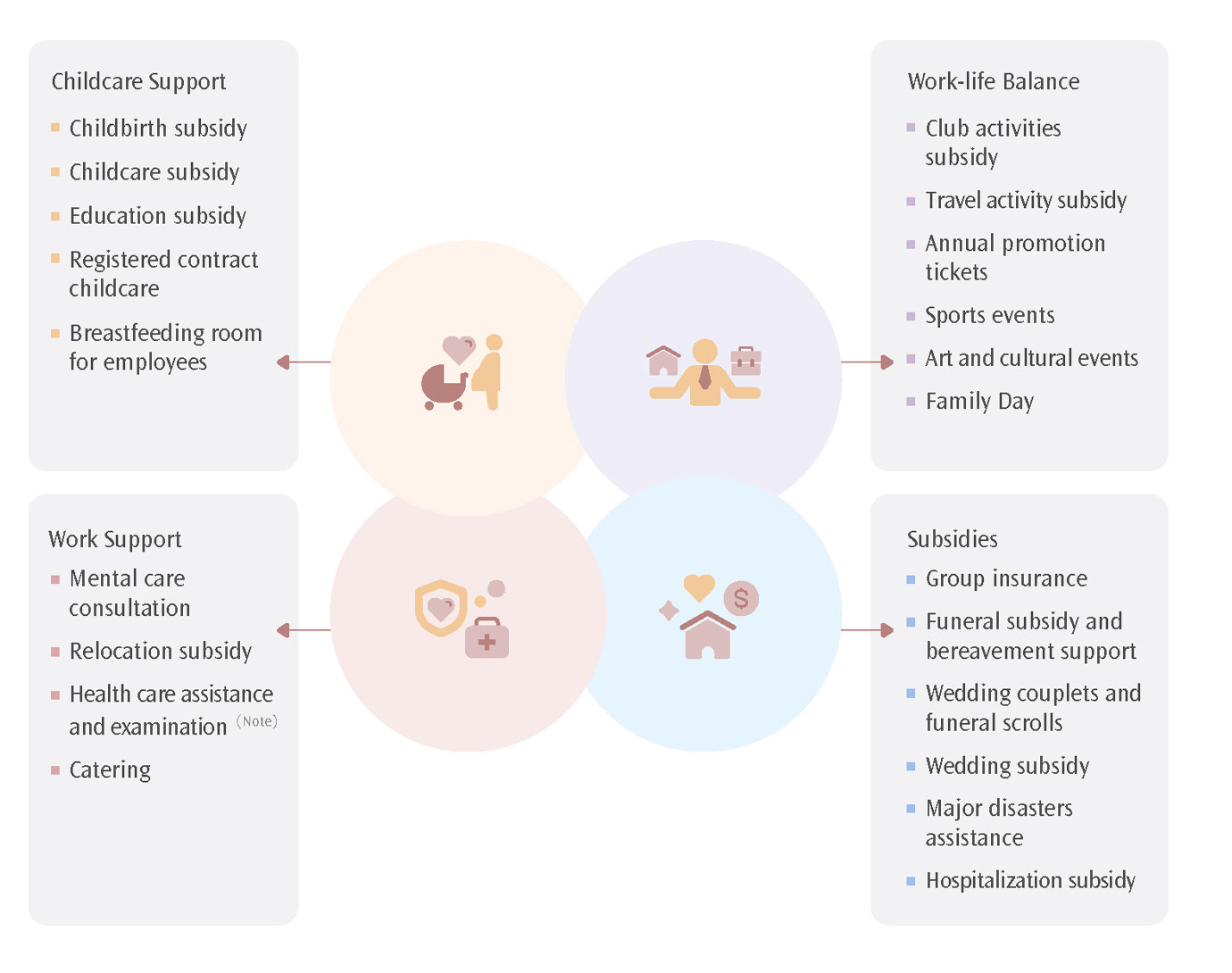
Note: THSRC's health examination measures are superior to those stipulated in the relevant laws and regulations, where general employees aged 45 years old and above undergo health examination once a year, and those aged under 45 years old undergo health examination once every two years, while train personnel undergo health examination once a year. The 2024 annual health examination for general and train personnel was completed from March to August, and 100% of train personnel completed the health examination.
Implementation of retirement plan system
To provide stable lifestyles for employees after retirement, the Corporation has set retirement procedures in accordance with law, and has established a Pension Reserves Supervisory Committee which convenes every quarter to discuss distribution of pensions and other matters.
The Corporation has established a retirement benefits plan according to the Labor Standards Act and the Labor Pension Act
(a) Defined benefit plan: Includes pension plans under the Labor Standards Act and the Labor Pension Act, as well as prior pension plans where tenure of services rendered was retained. The Corporation places 2% of employee monthly salaries into pension funds, and these are turned over to the Pension Reserves Supervisory Committee and deposited in a special savings account at the Bank of Taiwan in the Committee's name. Qualified actuaries review pension reserves every year and the Pension Reserves Supervisory Committee convenes periodically in accordance with relevant laws to protect the pensions and rights of our employees.
(b) Defined contribution plan: Includes pension plans under the Labor Pension Act. The Corporation places 6% of employee monthly salaries in individual labor insurance accounts to serve as pension reserves.
(c) Pension distribution table
| Pension Plan | Defined benefit plan | Defined contribution plan |
|---|---|---|
| Applicable Law | Labor Standards Act | Labor Pension Act |
| Pension Contributions | We contribute 2% of employee salaries into pension funds each month |
We contribute 6% of employee salaries into pension funds each month |
| We contributed a total of NT$ 17,056 thousand to pension funds in 2023 |
We contributed a total of NT$ 208,305 thousand to pension funds in 2023 |
Retirement conditions
(a) Voluntary retirement: An employee may apply for voluntary retirement under any of the following conditions:
I. Has reached the age of fifty-five and has worked for fifteen years.
II. Has worked for more than twenty-five years.
III. Has reached the age of sixty and has worked for ten years.
(b) Forced retirement:
I. Has reached the age of sixty-five.:
II. Is unable to perform his/her duties due to disability.
(c) Pension payments and standards:
I. Defined benefit plan: Employers shall pay employee pensions within 30 days from the day of retirement. According to Article 55 of the Labor Standards Act, pensions are calculated according to bases of tenure of services rendered and the six-month average salary amount following approval of retirement application. Two bases are given for each full year of service rendered. But for the rest of the years over 15 years, one base is given for each full year of service rendered. The total number of bases shall be no more than 45. An additional 20% on top of the amount calculated according to the preceding subparagraph shall be given to workers forced to retire due to disability incurred from the execution of their duties.
II. Defined contribution plan: According to the Labor Pension Act and relevant regulations, employees under the new pension system can collect pensions from their pension reserve accounts directly from the Bureau of Labor Insurance.
